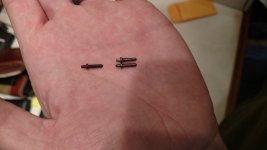FrankenMauser
New member
I have a 1936 Remington 241 that has been a chronic pain in the backside of several family members for at least 30 years (maybe more).
It has, almost since the first day it came into my family, had an issue with randomly short-stroking and failing to eject. That, in turn, sometimes results in failures to feed when it barely manages to eject. And, on occasion, it fails to feed while stove-piping.
For the record: I have tested with all "power levels" of .22 LR ammunition. From 'standard velocity', to 'high velocity', to 'hyper velocity'; it all runs the same.
In all my tinkering with and cussing at this thing, I've decided that the magazine cutoff is working as intended (the weird toggle link with a pointed hook on the end, that has no spring, but interacts with the top of the slide). And, based on just an 'ejumacated' guess, I believe the recoil spring and firing pin spring to be adequate for the bolt.
However, when running action proving dummies or other real ammunition through the action (when safe to do so), I often see more than one cartridge 'pop' right through the cartridge stop on the feed ramp.
So, I believe the problem to be the cartridge stop. (Totally different design than the Remington 24 and Browning SA-22.)
The spring is strong. I've tried a new replacement, with the same results.
And the cartridge stop looks good. But it may be worn from the ~50 years of unknown use prior to coming into my family.
So... should I go ahead and try to have a cartridge stop reproduced by a machine shop or gunsmith? (I lack the capability to do it myself; and they are not available as replacement parts.)
Or am I missing something else?
It has, almost since the first day it came into my family, had an issue with randomly short-stroking and failing to eject. That, in turn, sometimes results in failures to feed when it barely manages to eject. And, on occasion, it fails to feed while stove-piping.
For the record: I have tested with all "power levels" of .22 LR ammunition. From 'standard velocity', to 'high velocity', to 'hyper velocity'; it all runs the same.
In all my tinkering with and cussing at this thing, I've decided that the magazine cutoff is working as intended (the weird toggle link with a pointed hook on the end, that has no spring, but interacts with the top of the slide). And, based on just an 'ejumacated' guess, I believe the recoil spring and firing pin spring to be adequate for the bolt.
However, when running action proving dummies or other real ammunition through the action (when safe to do so), I often see more than one cartridge 'pop' right through the cartridge stop on the feed ramp.
So, I believe the problem to be the cartridge stop. (Totally different design than the Remington 24 and Browning SA-22.)
The spring is strong. I've tried a new replacement, with the same results.
And the cartridge stop looks good. But it may be worn from the ~50 years of unknown use prior to coming into my family.
So... should I go ahead and try to have a cartridge stop reproduced by a machine shop or gunsmith? (I lack the capability to do it myself; and they are not available as replacement parts.)
Or am I missing something else?

